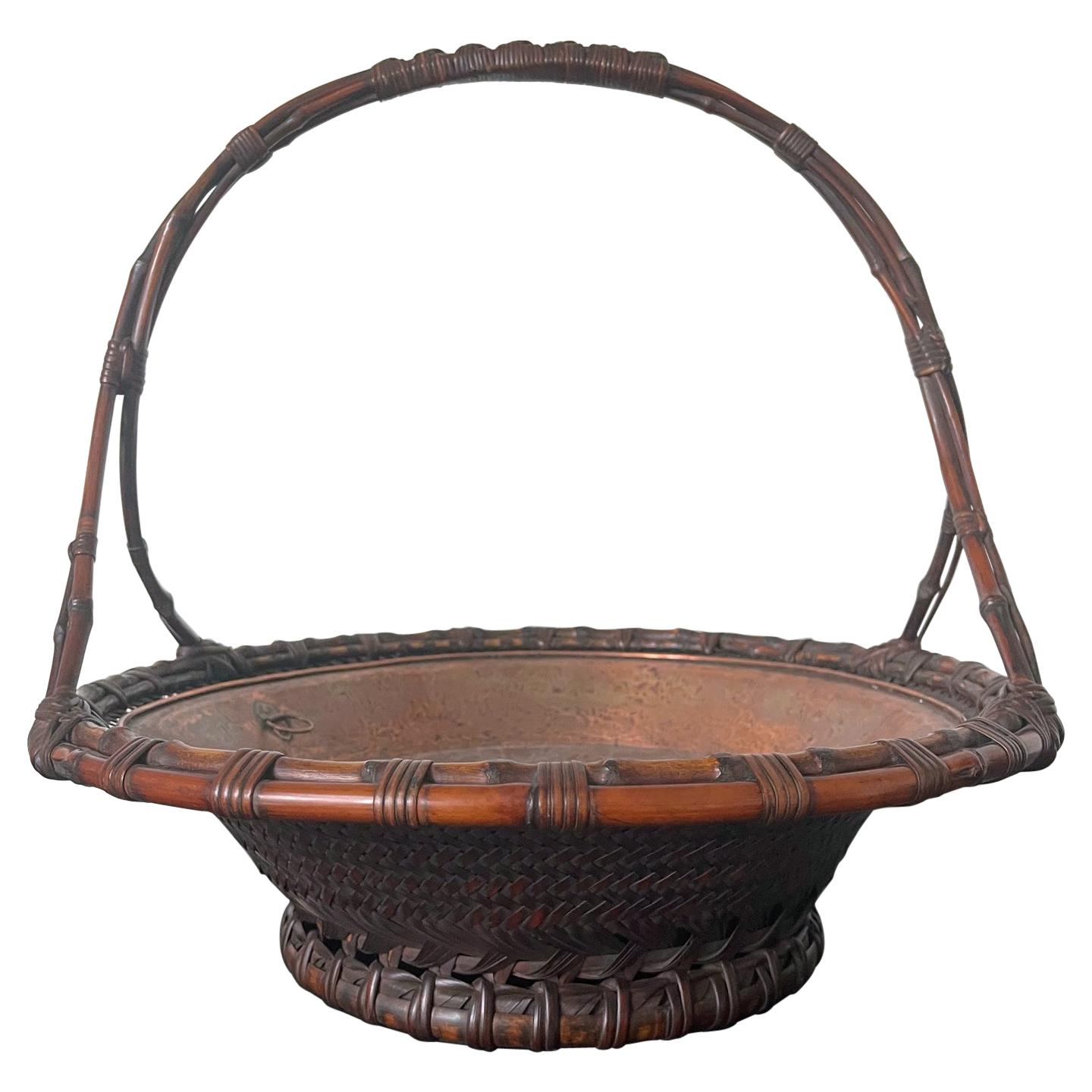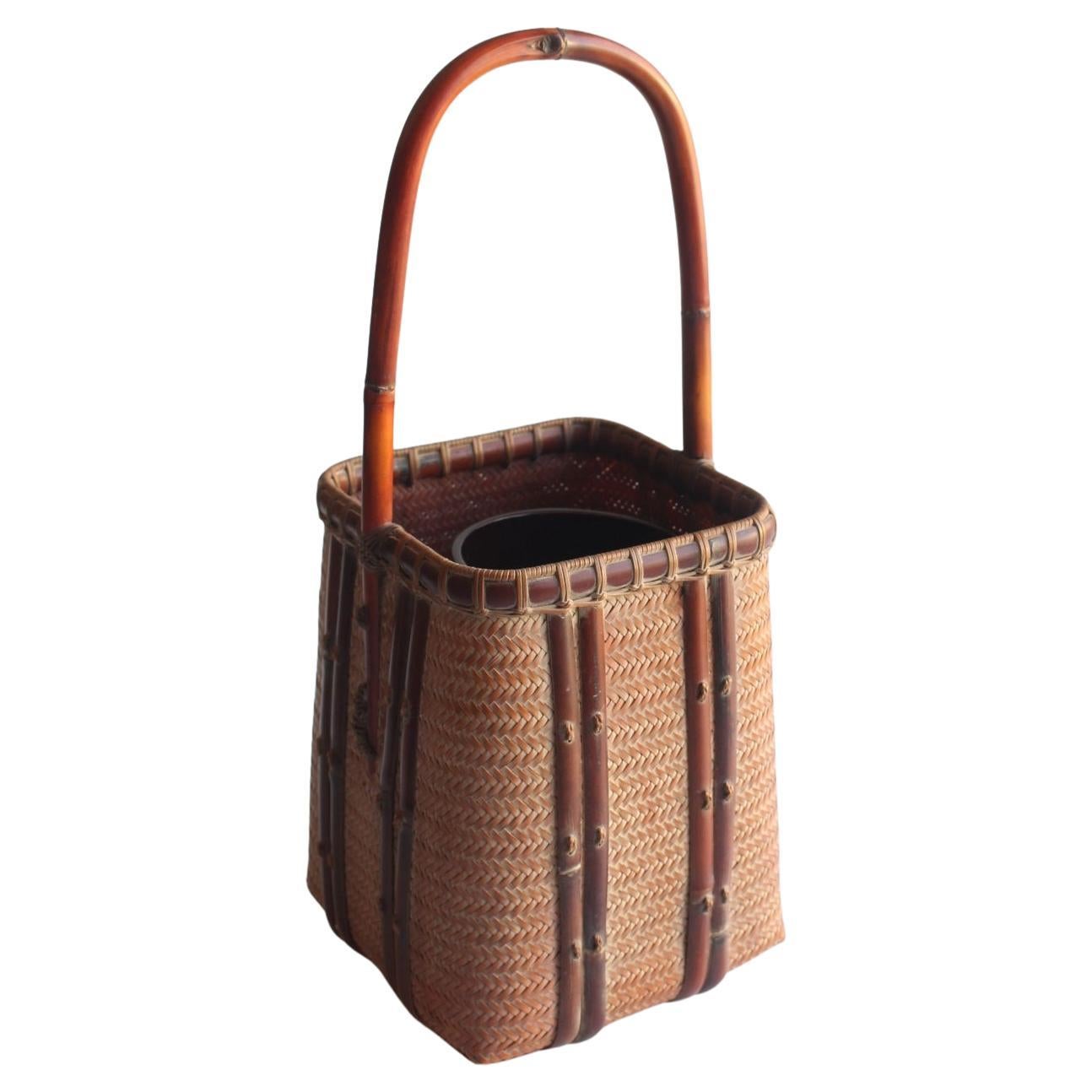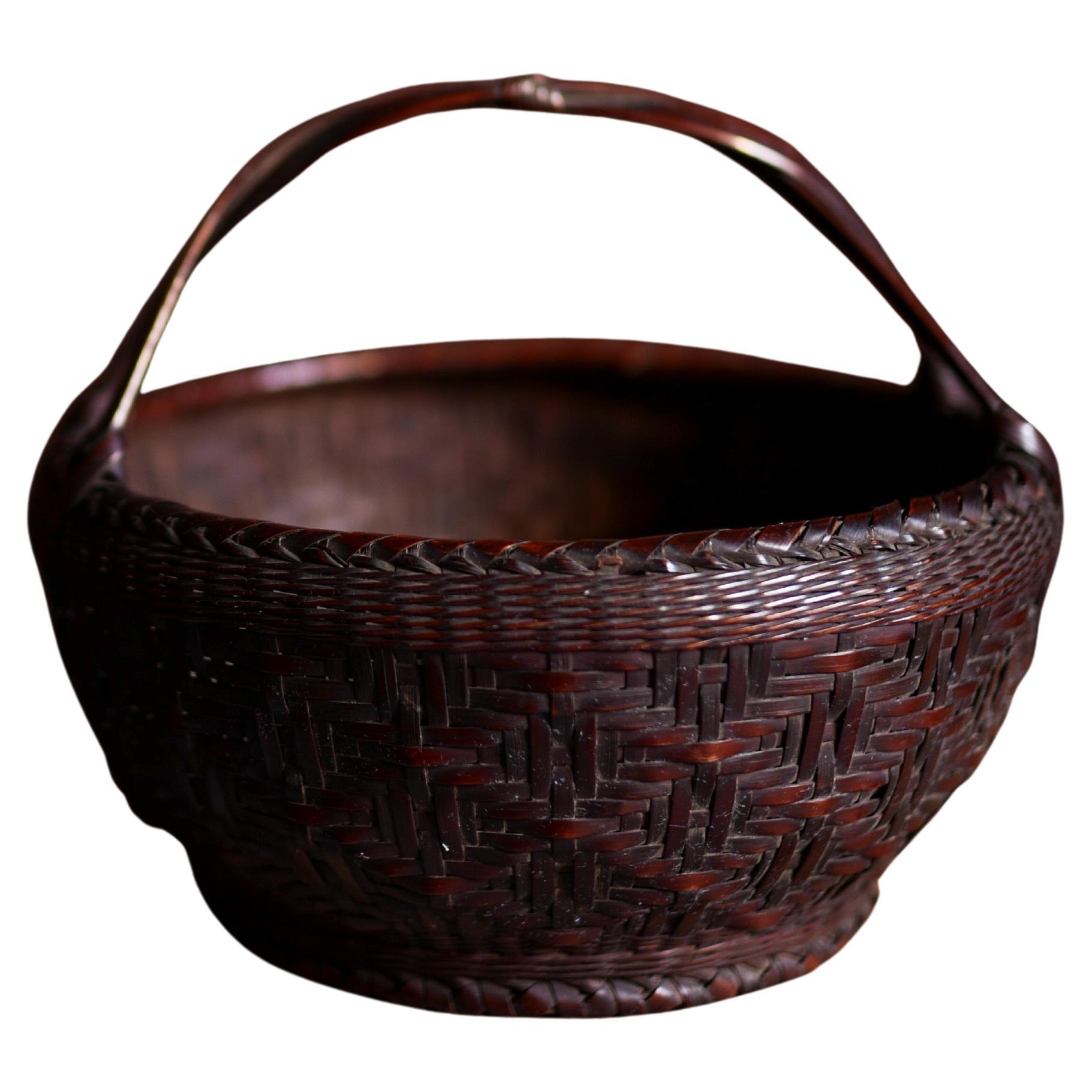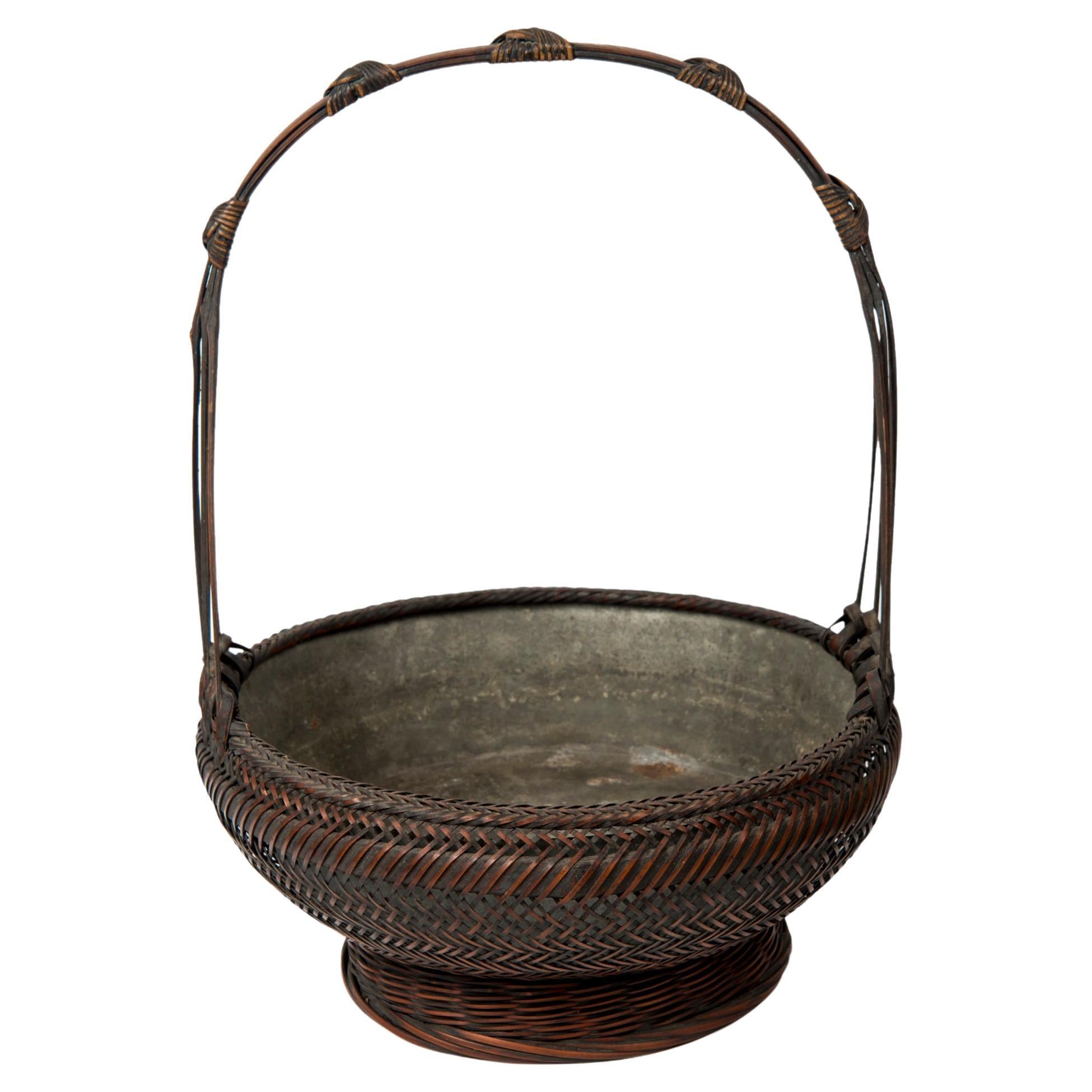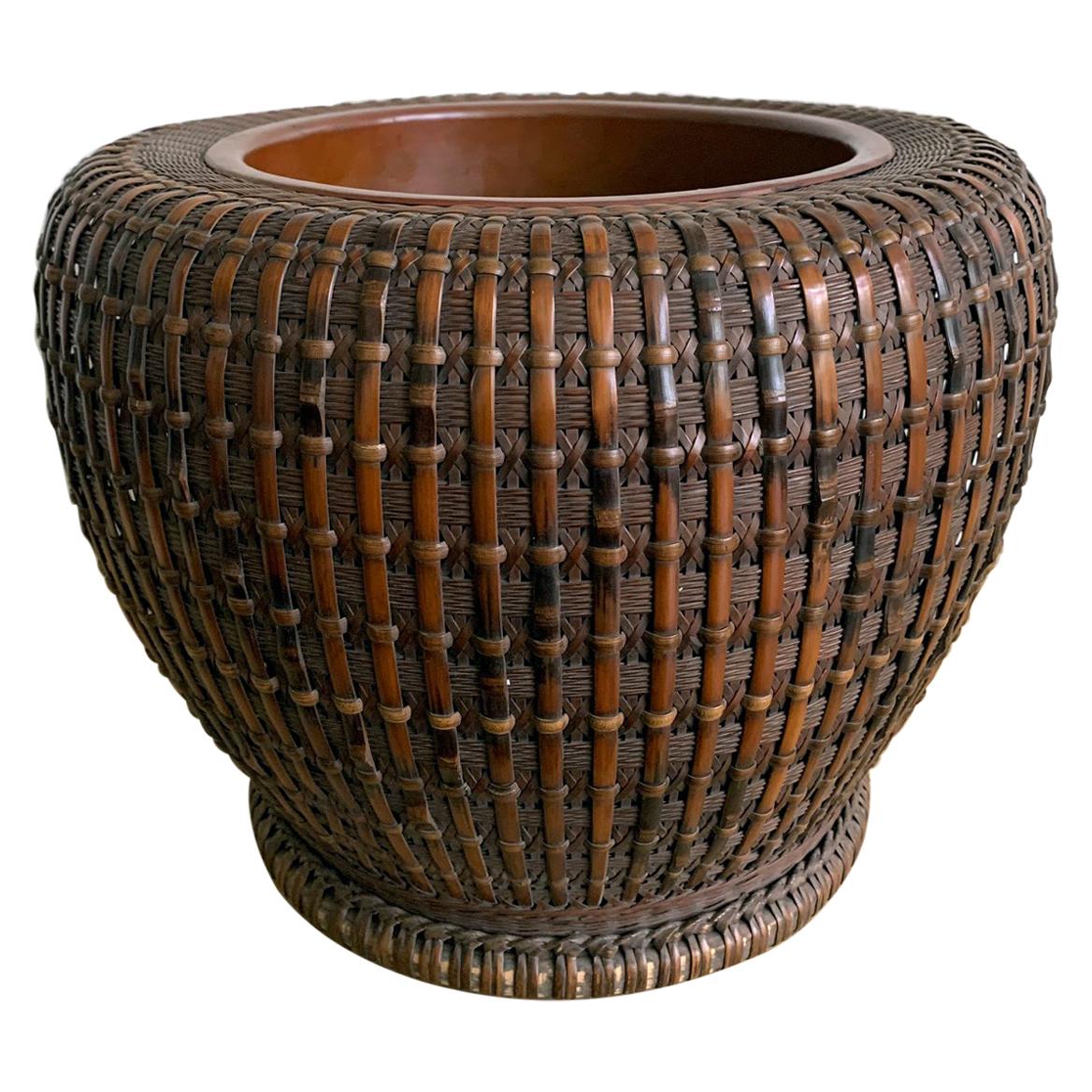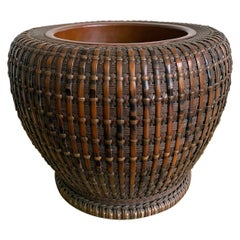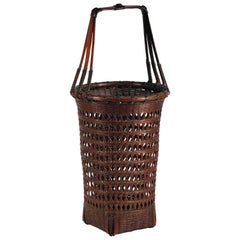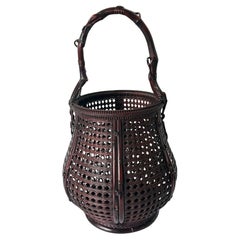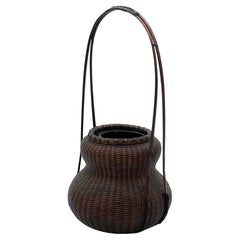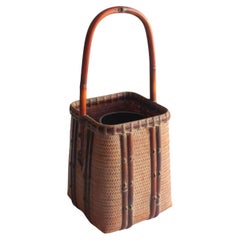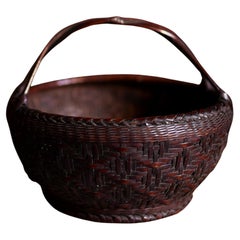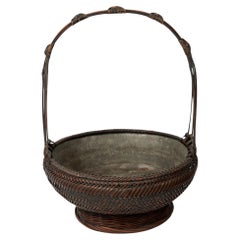Items Similar to Early Japanese Hand Basket with Brocade Interior by Suzuki Gengensai
Want more images or videos?
Request additional images or videos from the seller
1 of 11
Early Japanese Hand Basket with Brocade Interior by Suzuki Gengensai
$5,800
£4,373.78
€5,058.48
CA$8,137.37
A$9,045.19
CHF 4,741.30
MX$110,463.67
NOK 59,192.34
SEK 55,688.95
DKK 37,755.04
About the Item
This small elegant woven bamboo basket was meant to be a hand-hold bag with its brocade interior (which appears original). It was made by Suzuki Gengensai (1891-1950) circa 1910-20s. Suzuki Gengensai was from Kansai region and active in Osaka. He studied bamboo art under Yamashita Kochikusai (1876-1947) and became an independent artist in 1913. He received his artist name Gengensai in 1914 and in 1923 he changed the characters to Gen, a slight written variation of the character. This basket was signed in the former way, which helps to date the piece to the early part of the artist's career circa 1914-1923.
The basket is tightly woven in variation of twill plating that creates contrasting bands on the surface. The base was constructed with short bamboo stripes on the corners and side with ornamental knots.
A closely related piece (Object Number: 2006.3.651) with slight different surface twill patterns is in the collection of Asian Art Museum San Francisco. Comparing the two, they show almost identical form as well as the base construction. Both also have brocade interior and most likely were woven during the same period.
Another documented example can be found on page 180 in "Baskets Masterpieces of Japanese Bamboo Art 1850-2015". A utensil basket with twill plating and bears the signature of the same variation.
Provenance: Collection of Zen Art, Dr. Karl Hennig, Hamburg, Germany.
- Creator:Suzuki Gengensai (Artist)
- Dimensions:Height: 6 in (15.24 cm)Width: 7.5 in (19.05 cm)Depth: 4.35 in (11.05 cm)
- Style:Japonisme (Of the Period)
- Materials and Techniques:Bamboo,Brocade
- Place of Origin:
- Period:
- Date of Manufacture:1914-1923
- Condition:Wear consistent with age and use. Nice patina, minor wear along the rim, brocade partially covers the interior wall as intended and no longer completely attached to the wall and there are loose threads on the edge. The brocade base appears wholesome.
- Seller Location:Atlanta, GA
- Reference Number:1stDibs: LU945023701882
About the Seller
4.9
Platinum Seller
Premium sellers with a 4.7+ rating and 24-hour response times
Established in 2006
1stDibs seller since 2010
567 sales on 1stDibs
Typical response time: <1 hour
- ShippingRetrieving quote...Shipping from: Atlanta, GA
- Return Policy
Authenticity Guarantee
In the unlikely event there’s an issue with an item’s authenticity, contact us within 1 year for a full refund. DetailsMoney-Back Guarantee
If your item is not as described, is damaged in transit, or does not arrive, contact us within 7 days for a full refund. Details24-Hour Cancellation
You have a 24-hour grace period in which to reconsider your purchase, with no questions asked.Vetted Professional Sellers
Our world-class sellers must adhere to strict standards for service and quality, maintaining the integrity of our listings.Price-Match Guarantee
If you find that a seller listed the same item for a lower price elsewhere, we’ll match it.Trusted Global Delivery
Our best-in-class carrier network provides specialized shipping options worldwide, including custom delivery.More From This Seller
View AllLarge Japanese Woven Bamboo Morikago Basket by Maeda Chikubosai I
By Maeda Chikubosai
Located in Atlanta, GA
A large and impressive Japanese basket in the form of a morikago by Maeda Chikubosai I (1872-1950) circa first half of the 20th century. Chikubosai I was from the Kansai Region and active in Sakai, Osaka prefecture. He was instructed by Wada Waichisai I, (1851-1901).
Morikago is a shallow open basket with handle. It was traditionally used to display fruits, sometimes flowers, during Sencha tea ceremony. In contrast to Chanoyu, Sencha ceremony uses loose green tea leaves instead of tea powder. The placement of loose fruits in the basket meant that the pattern of the bottom, which is often elaborate, was meant to be visible.
This morikago was beautifully constructed with bent bamboo frame and twill plaits for the body. The bottom of the basket features a double diamond pattern achieved with a variation of plover plait. The bifurcated handles was bundle-plated with a rather free spirit approach. They show a poetic suggestion of movement, as if the bamboos were still swaying in the wind. The basket has a copper insert that fits perfectly and it is quite possibly the original. The basket is signed on the base "Chikubosai". The style of the signature shows that it was made by Maeda Chikubosai I.
For another Morikago basket by Maeda Chikubosai I, see page 79 of "Masters of Bamboo" by Rinne.
For the study of the signature of Chikubosai I "Baskets Master Pieces of Japanese Bamboo Art...
Category
Early 20th Century Japanese Japonisme Decorative Baskets
Materials
Copper
Japanese Woven Bamboo Brazier by Maeda Chikubosai I
By Maeda Chikubosai
Located in Atlanta, GA
An important piece of bamboo basketry art by Maeda Chikubosai I (1872-1950), circa 1920s-1930s. The body of the bamboo brazier was made with smoked bamboo (susudake) and rattan and with a built-in copper liner brazier. Mat plaiting, diagonal plaiting and twining were used to construct the robust body while hexagonal plaiting was used for the base. It is signed on the base Chikubosai Kore o tsukuru (Chikubosai made this). The copper brazier...
Category
Vintage 1920s Japanese Japonisme Decorative Baskets
Materials
Copper
Japanese Bamboo Basket Ikebana by Yamashita Kochikusai
By Yamashita Kochikusai
Located in Atlanta, GA
Yamashita Kochikusai (1876-1947) was a bamboo artist from Osaka, Kansai region. He apprenticed under Wada Waichisai I (1851-1901), becoming independent in 1901. His students include ...
Category
Vintage 1920s Japanese Japonisme Decorative Baskets
Materials
Bamboo
Japanese Woven Ikebana Bamboo Basket Maeda Chikubosai I
By Maeda Chikubosai
Located in Atlanta, GA
A woven bamboo ikebana hanakago (flower basket) with handle circa first half of the 20th century (Taisho or Showa era) by Japanese bamboo master Maeda Chikubosai I (1872-1950). In th...
Category
Early 20th Century Japanese Modern Vases
Materials
Bamboo
Japanese Woven Ikebana Bamboo Basket Maeda Chikubosai I
By Maeda Chikubosai
Located in Atlanta, GA
A tall woven bamboo ikebana hanakago (flower basket) circa first half of the 20th century (Taisho or Showa era) by Japanese bamboo master Maeda Chikubosai I (1872-1950). Hand-woven w...
Category
Early 20th Century Japanese Modern Vases
Materials
Bamboo
Japanese Bamboo Basket Ikebana Suzuki Gengensai
By Suzuki Gengensai
Located in Atlanta, GA
An elegantly woven bamboo basket with handle as an ikenana container by Suzuki Gengensai (1891-1950) circa 1923-50. Suzuki Gengensai was from Kansai region and active in Osaka. He studied bamboo art under Yamashita Kochikusai (1876-1947) and became an independent artist in 1913. He received his artist name Gengensai in 1914 and in 1923 he changed the characters to Gen, a slight written variation of the character. This basket was signed in this later variation, which helps to date the piece to post 1923.
The basket is woven entirely in a free style irregular plating on the body and with a twisted bundled handle. The surface is lacquered in a deep reddish color. The seemingly less rigid technique renders the piece a more rustic and natural aesthetic that is more suitable for certain occasions. It is singed on the base with artist's signature in the variation post 1923.
A very similar basket of the irregular weaving but without the handle is illustrated in plate 72 in "Baskets Masterpieces of Japanese Bamboo Art...
Category
20th Century Japanese Japonisme Scholar's Objects
Materials
Bamboo
You May Also Like
Japanese Late Meiji Period Woven Bamboo Tea Ceremony Basket, Early 20th Century
Located in New York, NY
Japanese Late Meiji Period Woven Bamboo Tea Ceremony Basket, Early 20th Century
PERIOD
Meiji Period (1868-1912)
DIMENSIONS
Height: 11.5 INCHES
Diameter: 5 inches
ABOU...
Category
Early 20th Century Japanese Japonisme Decorative Baskets
Materials
Bamboo
Japanese Antiques Keizo Yagisawa (Sokan) A Flower Basket Bamboo Craft with Box
Located in Niiza, JP
A bamboo craft artist who studied under Living National Treasure Katsushiro Souho.
Established the "Yagisawa Bamboo Workshop" in Otawara, Tochigi Prefecture
Specializes in detailed m...
Category
20th Century Japanese Antiquities
Materials
Bamboo
Japanese Handwoven Bamboo Basket with Handle, Hanakago, Japan, 20th Century
Located in Edogawa-ku Tokyo, JP
A finely crafted Japanese a handwoven bamboo basket with an arched handle.
Made from naturally darkened bamboo, the basket features an intricate geometric weave and a gracefully cur...
Category
Early 20th Century Japanese Decorative Baskets
Materials
Bamboo
Japanese ikebana banakago basket of Chinese style
Located in PARIS, FR
Handled circular ikebana basket (hanakago) in Chinese style, in vanished bamboo and rattan. Inside in copper alloy.
Ikebana or Ka-do (the way of flowers) is a traditional Japanese a...
Category
Antique Late 19th Century Japanese Meiji Decorative Baskets
Materials
Bamboo, Rattan
Early 20th century Large signed Bamboo Basket
Located in Fukuoka, JP
Fine Ikebana Bamboo Basket. Bamboo with natural patination.
Age: early 20th century
Good conditionwith some abrasions and patination.
Size : 65.5/19/16cm ( 27.5/7.5/6.3inch )
...
Category
Early 20th Century Japanese Meiji Decorative Baskets
Materials
Bamboo
Intricately woven Japanese art basket, 1900-50
Located in Kenilworth, IL
Vintage Japanese open top woven basket. The basket features a broad bent bamboo handle which is reinforced by angled bamboo stays lashed to the handle at both the bend in the handle ...
Category
Early 20th Century Japanese Decorative Baskets
Materials
Bamboo, Rattan
More Ways To Browse
Antique Japanese Basket
Antique Bamboo Baskets
Small Woven Basket
Japanese Bamboo Basket
Japanese Woven Basket
Signed Bamboo Basket
Antique Japanese Woven Baskets
Italian Rattan Basket
Antique Woven Basket
Harvest Basket
Harvesting Basket
Decorative Brass Bowls With Handles
Leather Basket Italy
Baskets with Lids
Antique Oak Basket
Antique Bamboo Baskets
Small Woven Basket
French Wicker Basket

